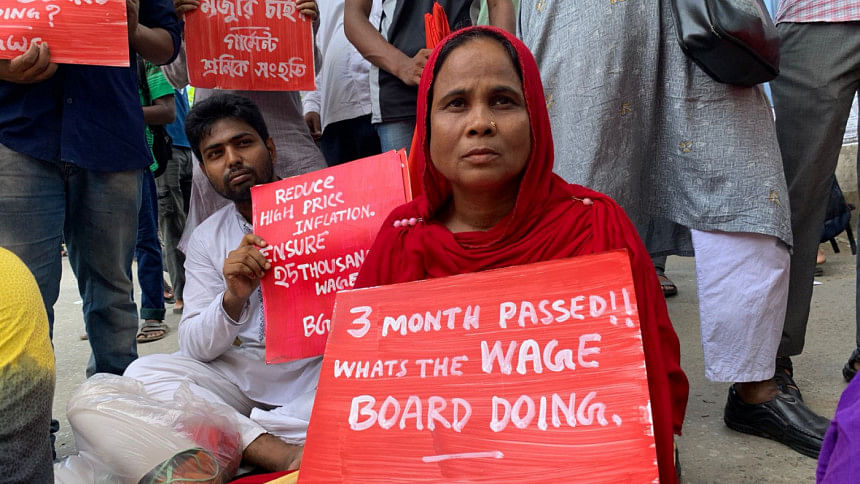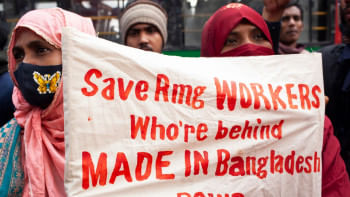The minimum wage question: Owner's profit versus worker's survival

In a recent interview with BBC Bangla, the UN Special Rapporteur on extreme poverty and human rights, Olivier de Schutter, said, "The minimum wage in the readymade garment sector is Tk 8,000 per month, which is probably one-third of what would allow a worker in this industry to make a decent living and to support his or her family. Unfortunately, when the unions demand higher wages, the response given to them is that if the wages are not kept low, the big buyers will move to other countries, will cancel their orders, and the competitiveness of Bangladesh in global markets will be threatened. I do not think that the development of a country can be premised on keeping workers in poverty."
As indicated by Schutter, BGMEA President Faruque Hassan has indeed said that if the wages of workers in the garment sector are increased, there will be no buyers for the garments made in Bangladesh. The factories will be closed and the workers will not have jobs altogether.
Such statements by garment owners is nothing new. Whenever the demand for wage increase is raised, they retort that if the wages are increased, their competitiveness will decrease, many of them will have to close shop, and as a result, thousands of workers will become unemployed and so on. Some may remember that the same spectre of factory closure was evoked during the wage hike from around Tk 900 to Tk 1,662 in 2006, to Tk 3,000 in 2010, to Tk 5,300 in 2013, and finally to Tk 8,000 in 2018. Did the garment sector really face damages after increasing workers' wages?
The debate over wage increase has risen at a time when the majority of people in the country are suffering due to skyrocketing commodity prices and a massive increase in the costs of living. Notably, as the taka has depreciated by 25.58 percent against the US dollar in the last one year, the garment exporters are now getting Tk 107.5 per dollar instead of Tk 86.45. As a result of taka devaluation, the pressure of inflation is on the workers, but the share of this additional income of the garment exporters is not reaching them.
The question may arise as to how workers' families are surviving. The answer is: they are living a barely minimum life by eating less, sleeping in unhealthy and crowded rooms, and suffering from diseases and malnutrition. It is not possible for the workers' families to avail essential materials to live healthy lives, as the wage is much lower than what is necessary.
In response to the demands of garment workers and unions, a new RMG wage board was formed in April this year. Garment workers are demanding that the minimum wage be increased from Tk 8,000 to Tk 25,000. In such a situation, what should be in consideration when revising the minimum wage? Maintaining the competitiveness of garment exporters or giving workers a minimum living wage?
I will argue that, like any other raw material, the price of labour should not be less than the cost of production. In addition to labour, many other raw materials are required for production. How do garment owners react when the prices of other raw materials increase? When the prices of, say, yarn, dyes, fuel, or machinery increase, do they tell suppliers that they will not pay the increased price because, if they do, they will not be able to survive in the competitive market? Certainly not. This is not how the market works.
When garment owners think they may face losses due to the price increase of raw materials or machineries, they either increase the price of their products or decrease the cost of production by increasing productivity. So, while a factory owner readily pays a higher price for all kinds of raw materials and machineries, excuses are only presented when it comes to paying a fair price for the labour purchased from workers.
Like other commodities, the price of labour depends on the cost of production. How is the production cost of labour determined? It is calculated as the cost of keeping the worker well and of developing them as a worker. Now, if a labourer is not paid the minimum wages necessary for them to procure adequate amounts of food, clothing, shelter, proper education, health care, entertainment, etc, then the workers will have to reproduce labour power with less input, for which the worker and his/her family will suffer from malnutrition, their vitality will diminish, their health may deteriorate, and both the worker and their family will become worn out.
Given this background, what is the current condition of working people in Bangladesh? Are the wages they are paid enough for them to live a humane life and reproduce labour properly? According to research by the South Asian Network on Economic Modeling (Sanem), garment workers earn less than half what they need to fulfil the basic needs of food, housing, and healthcare. On average, a worker earned Tk 9,984 per month in the April-June quarter of 2022, while their living wage – the money required to be able to afford a decent standard of living – ranged from Tk 19,200 to Tk 26,000 depending on the areas they resided in. This translates to a gap of 51 to 60 percent between the workers' actual income and their minimum need.
The question may arise as to how workers' families are surviving. The answer is: they are living a barely minimum life by eating less, sleeping in unhealthy and crowded rooms, and suffering from diseases and malnutrition. It is not possible for the workers' families to avail essential materials to live healthy lives, as the wage is much lower than what is necessary. A study by the Bangladesh Garment Sramik Samhati showed that the workers can never afford good quality rice, vegetables, fish, or meat. As the prices of all protein-rich foods were hiked, workers depended more on carbohydrates to meet their calorie requirements. But due to the recent increase in the prices of flour and rice, they now have to reduce their intake of carbohydrates as well.
In a market economy, working people have nothing but their labour to sell. Under the market dynamics of demand and supply, and the collective power of factory owners, workers are often forced to sell their labour at a price lower than the cost of production, just to be able to survive. This may be profitable for the industry owners in the short term. But in the long run, it is not sustainable for either the owners or the overall economy. Rather, if the workers are paid a living wage, their purchasing power will increase and, as a result, the internal market of the country will develop and the economy will grow sustainably.
I cannot but agree with Olivier de Schutter in advocating a new form of development for Bangladesh: one driven by domestic demand rather than exploitative export opportunities. And for this, there is no alternative to fixing a living wage for the working people of the country.
Kallol Mustafa is an engineer and writer who focuses on power, energy, environment and development economics.

 For all latest news, follow The Daily Star's Google News channel.
For all latest news, follow The Daily Star's Google News channel. 










Comments